Do you remember eagerly turning over the pages of a new Shel Silverstein book as a child? It’s important to begin encouraging a love of poetry in kids as early as preschool or elementary school. However, it’s also important to remember that poetry can be an intimidating subject to learn (or teach!). How can we make it easier? By sharing some of the best and most inspiring famous poems with students.
Roald Dahl and even Maya Angelou have some great famous poems to introduce poetry concepts to the youngest readers. As students move on to middle school, inspire them with Robert Frost and contemporary famous poems by poets like Amanda Gorman. By high school, it’s time to delve into famous poems from Shakespeare, as well as unconventional works from poets like Sylvia Plath. Even Tupac gets a mention on our list! Check out our favorite famous poems for students of all ages.
FREE PRINTABLE
Free Poetry Worksheet Bundle
Grab our poetry worksheet bundle to pair with your poetry unit and make teaching poetry fun and simple.
Famous Poems for Elementary School
1. Jabberwocky by Lewis Carroll
“’Twas brillig, and the slithy toves
Did gyre and gimble in the wabe …”
Themes: Bravery, coming of age, good vs. evil
Literary devices: Portmanteau, repetition, assonance, alliteration, imagery
This well-known poem appeared in the sequel to Alice’s Adventure in Wonderland, Through the Looking Glass. It tells the tale of a hero who defeats various fantastical creatures.
2. The Homework Machine by Shel Silverstein
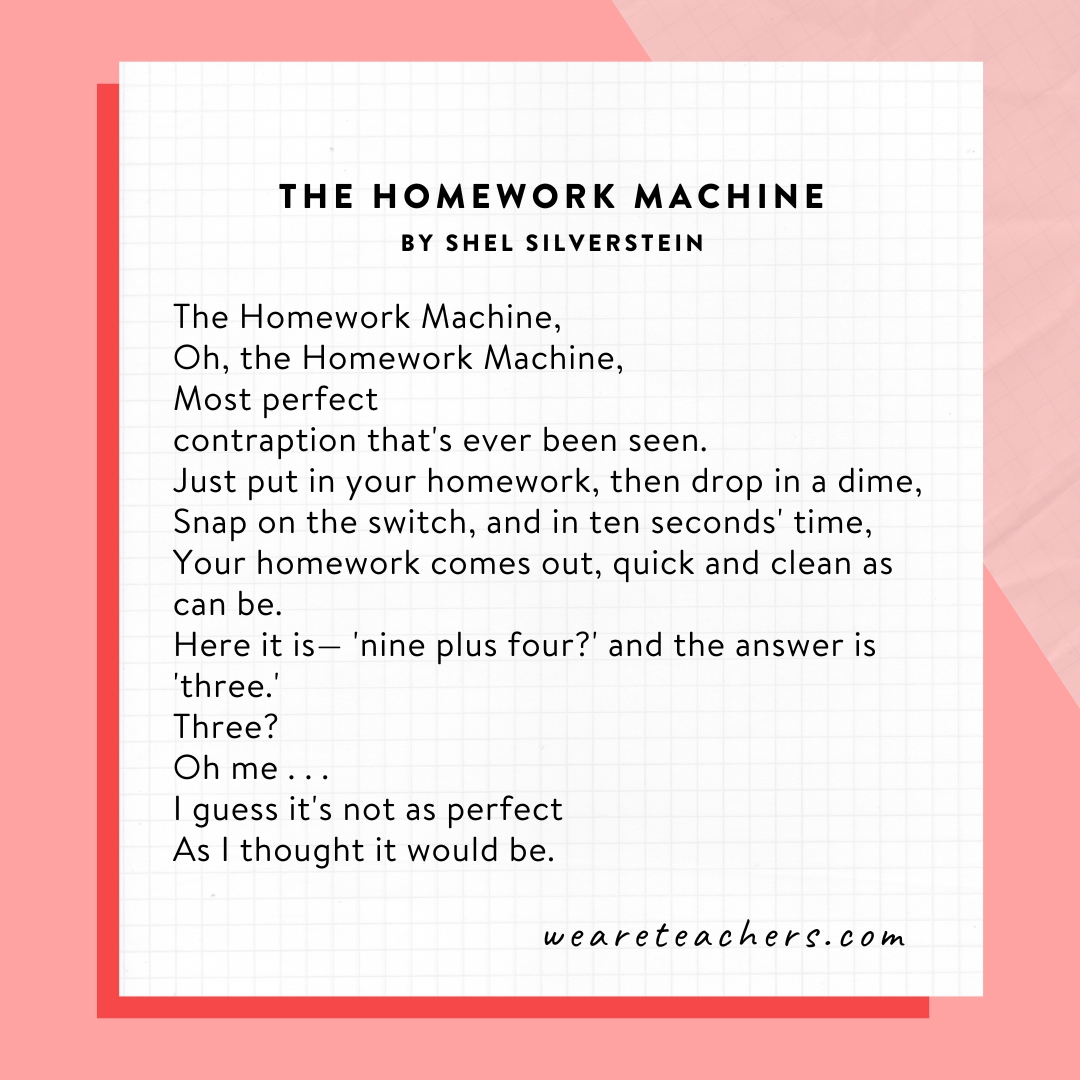
“Just put in your homework, then drop in a dime …”
Themes: Technology, unexpected consequences, personal responsibility
Literary devices: Rhyme, personification, hyperbole, humor
Shel Silverstein is famous for writing easy poems for kids to memorize and love. This whimsical poem utilizes humor and imagination to explore the consequences of the overuse of technology. It cautions against taking shortcuts while advocating for personal responsibility.
3. Life Doesn’t Frighten Me by Maya Angelou
“Shadows on the wall
Noises down the hall
Life doesn’t frighten me at all.”
Themes: Bravery, courage, empowerment, positive self-talk
Literary devices: Repetition, hyperbole, imagery
One of Maya Angelou’s most famous works, this poem may be seen as told through the eyes of a child. In it, she repeats the phrase “life doesn’t frighten me” almost so as to make herself believe it.
4. The Red Wheelbarrow by William Carlos Williams
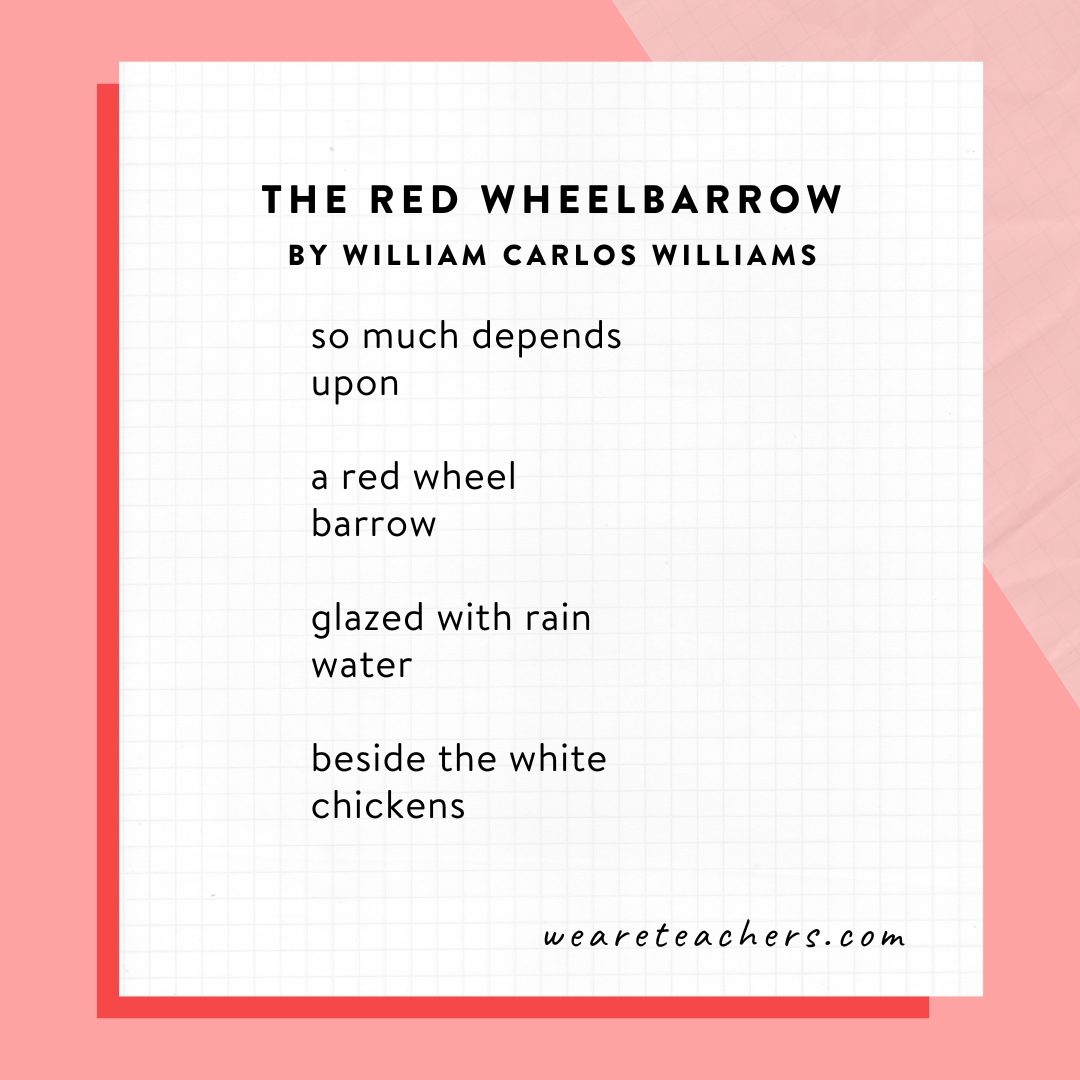
“so much depends
upon
a red wheel
barrow …”
Themes: Simplicity, nature, observation
Literary devices: Imagery, symbolism
This is a short and simple poem that uses a wheelbarrow to symbolize how even the simplest of objects or actions can have large implications. The short, broken lines force the reader to slow down and take in the simplicity of the setting.
5. Now We Are Six by A.A. Milne
“So I think I’ll be six now …”
Themes: Childhood, coming of age, friendship, innocence, passage of time
Literary devices: Rhyme, repetition
This is a short and simple poem that captures what it is like to be a child growing up. It utilizes a simple rhyming scheme as well as the repetition of the phrase “when I was.”
6. Firefly by Elizabeth Madox Roberts
“A little light is going by …”
Themes: Nature, mystery, simplicity, passage of time
Literary devices: Rhyme, repetition, imagery
While simple, this short, rhyming poem provides plenty of opportunity for discussion of various themes and literary devices. The simple firefly at the heart of the poem symbolizes the wonder of nature and the beauty that can be found in the simplest of things.
7. Happy Thought by Robert Louis Stevenson
“The world is so full of a number of things …”
Themes: Beauty, happiness, positivity
Literary devices: Rhyme
At just two lines long, this simple poem encapsulates the power of positivity and seeing the beauty in the world.
8. All My Great Excuses by Kenn Nesbitt
“Tornadoes blew my notes away …”
Themes: Imagination, responsibility, accountability, consequences, humor, playfulness
Literary devices: Rhyme, hyperbole, imagery
This fun poem lists out all the various excuses a child has for failing to do their homework. While playful and humorous, the ending indicates the consequences for the child’s lying as the teacher has figured them out.
9. maggie and milly and molly and may by e.e. cummings
“and maggie discovered a shell that sang …”
Themes: Personality, identity, nature
Literary devices: Rhyme, imagery, alliteration
The poet e.e. cummings creates a setting and characters in just a few lines. And, of course, there is the vocabulary: “languid,” “stranded,” “rays.”
10. Then Laugh by Bertha Adams Backus
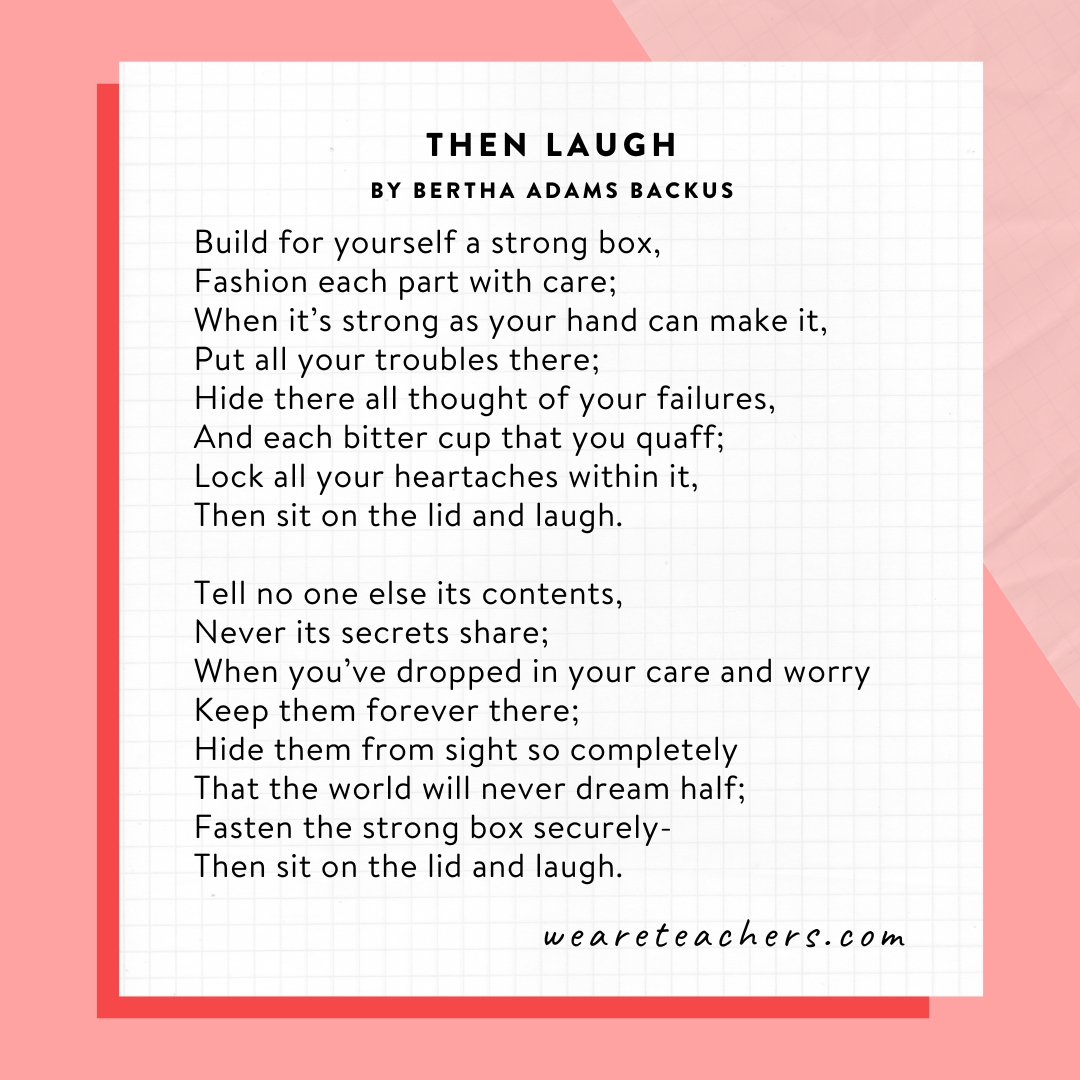
“Build for yourself a strong box …”
Themes: Adversity, positivity, optimism
Literary devices: Rhyme, imagery, metaphor, repetition
This poem contains a useful lesson for children on the benefit of not taking life too seriously. It uses repetition to implore the listener not to dwell on past failures or current worries.
11. One Fish Two Fish Red Fish Blue Fish by Dr. Seuss
“Black fish, Blue fish, Old fish, New fish.”
Themes: Playfulness, imagination
Literary devices: Rhyme, repetition, imagery
Dr. Seuss is famous for his children’s books that play with rhyme and language to set silly scenes. His writing definitely helps children learn to read and recognize rhyming patterns easily.
12. Wee Willie Winkie by William Miller
“Wee Willie Winkie runs through the town …”
Themes: Childhood, playfulness, routine, parenting
Literary devices: Alliteration, imagery, rhyme
This simple nursery rhyme utilizes both repetition and rhyme to paint a portrait of childhood and parenthood. The struggle of bedtime is a well-known one for children and parents alike, and this poem explores that through humor.
13. The Purple Cow by Gelett Burgess
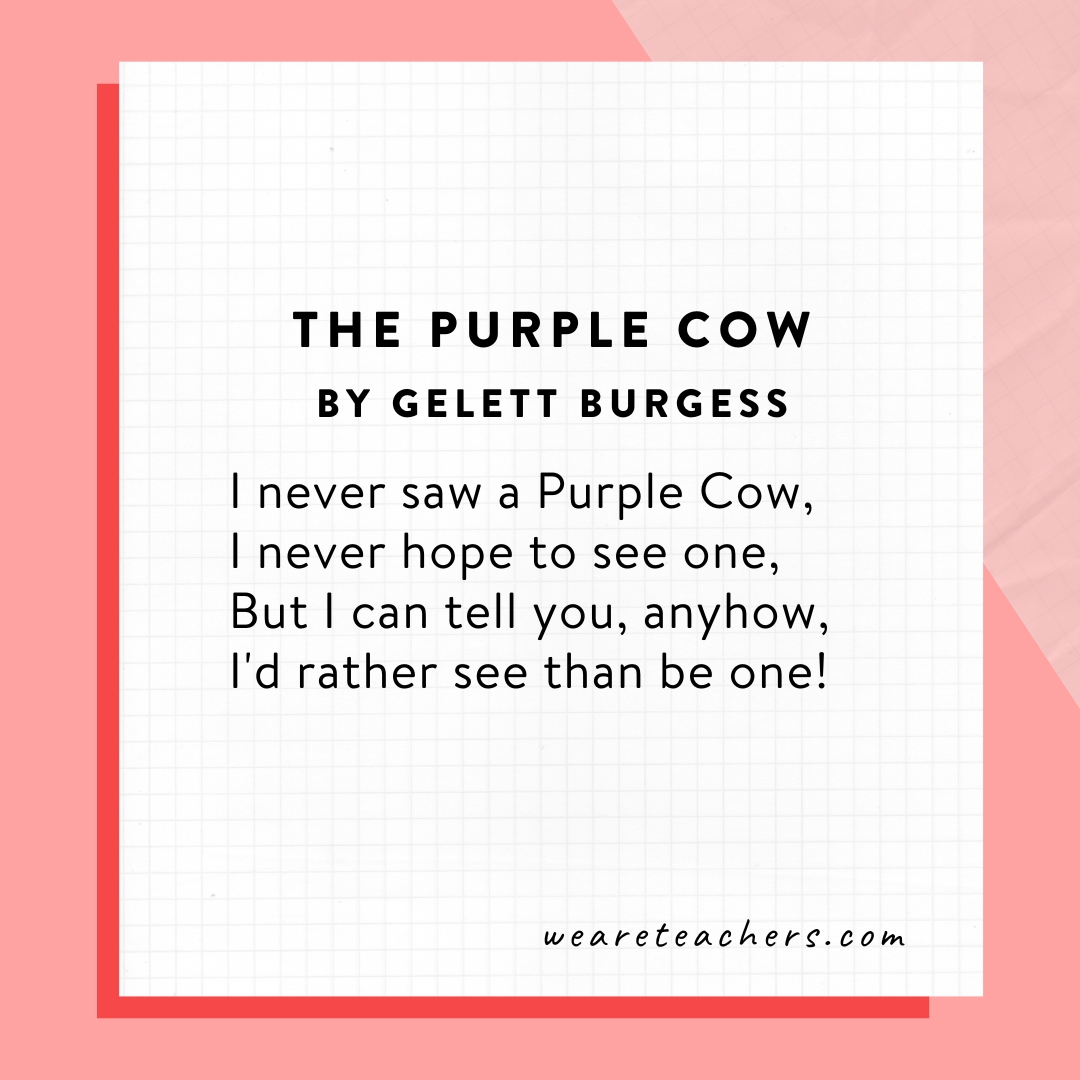
“I’d rather see than be one!”
Themes: Identity, assimilation, individuality
Literary devices: Repetition, rhyme
A short and sweet poem, you can invite students to discuss this poem and see what meaning they can glean from the idea that we’d rather “see than be” a purple cow.
14. Please Mrs. Butler by Allan Ahlberg
“Take your books on the roof, my lamb.”
Themes: Childhood, adult-child relationship, teaching, power dynamics
Literary devices: Repetition, rhyme, hyperbole, humor, contrast
This is another poem that focuses on childhood and the feelings experienced during that time. In it, the child repeatedly asks the speaker, presumably a teacher or authoritative figure, questions about how to deal with different situations. The adult’s dismissive responses seem to indicate that the adult would rather be left alone than help the child deal with each scenario.
15. The Owl and the Pussy-Cat by Edward Lear
“The Owl and the Pussy-cat went to sea …”
Themes: Adventure, love, fantasy
Literary devices: Rhyme, narrative structure, imagery
A whimsical poem that tells a fanciful story of an owl and a cat on a journey, it’s ideal for introducing storytelling elements, rhyme schemes, and discussing how poems can create entire worlds through imagery.
16. Matilda by Hilaire Belloc
“Matilda told such dreadful lies …”
Themes: Humor, mischief, consequences
Literary devices: Rhyme, alliteration, hyperbole
This poem tells the tale of a small girl who lies often regardless of the situation. In the end, the girl tells a lie so severe that a tragic consequence results.
17. Little Red Riding Hood and the Wolf by Roald Dahl
“He went and knocked on Grandma’s door.”
Themes: Lessons, consequences
Literary devices: Rhyme, hyperbole, personification
This is a classic nursery rhyme that has been transformed into movies, shows, and stories. It teaches a moral lesson while employing literary devices like a rhyming scheme and personification.
18. On Turning Ten by Billy Collins
“You tell me it is too early to be looking back …”
Themes: Coming of age, loss of innocence, nostalgia, memory
Literary devices: Symbolism, imagery, personification
This is a beautiful poem filled with vivid imagery that captures a moment in time during the speaker’s adolescence.
19. Stopping by Woods on a Snowy Evening by Robert Frost
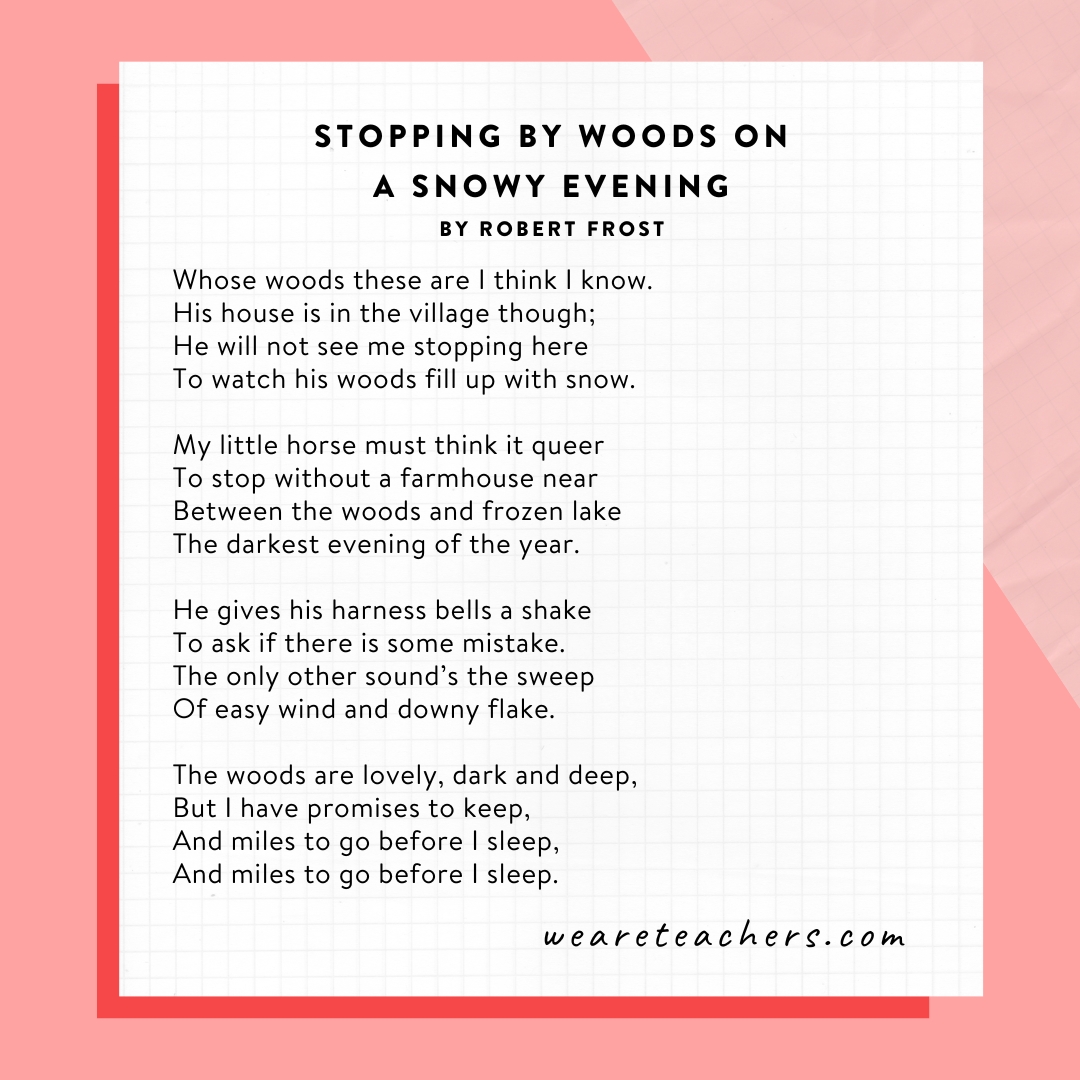
“Whose woods these are I think I know.
His house is in the village though …”
Themes: Life, responsibility, peace, solitude
Literary devices: Imagery, personification, symbolism, rhyme
If “The Road Not Taken” is Frost’s best-known poem, “Stopping by Woods on a Snowy Evening” is the most loved of Frost’s poems. The poem reads like a journal entry because it was inspired by an evening when Frost stopped by the woods on his way home. It’s a great entrance into Frost’s work and a wonderful example of how poets can create atmosphere with their words.
Famous Poems for Middle School
20. Paul Revere’s Ride by Henry Wadsworth Longfellow
“Listen, my children, and you shall hear …”
Themes: Patriotism, heroism, freedom
Literary devices: Symbolism, imagery, personification
This poem is an example of a narrative poem and was written right before the Civil War. The poem, while not historically accurate, focuses on themes of patriotism and heroism.
21. Sonnet 43 by William Shakespeare
“When most I wink, then do mine eyes best see …”
Themes: Love, longing, dreams vs. reality
Literary devices: Metaphor, paradox, imagery
One of Shakespeare’s most famous poems, this sonnet utilizes vivid imagery to explore the theme of the power of love. Darkness and light are contrasted against each other, as are dreams and reality.
22. A Red, Red Rose by Robert Burns
“O my Luve is like a red, red rose …”
Themes: Eternal love, longing, passage of time
Literary devices: Metaphor, simile, hyperbole
This poem explores the theme of love enduring over both distance and time while utilizing several literary devices. The very first line opens with a simile comparing the poet’s love to a rose. The poet employs vivid imagery derived from the natural world to express the depths of love felt for their beloved.
23. I Wandered Lonely as a Cloud by William Wordsworth
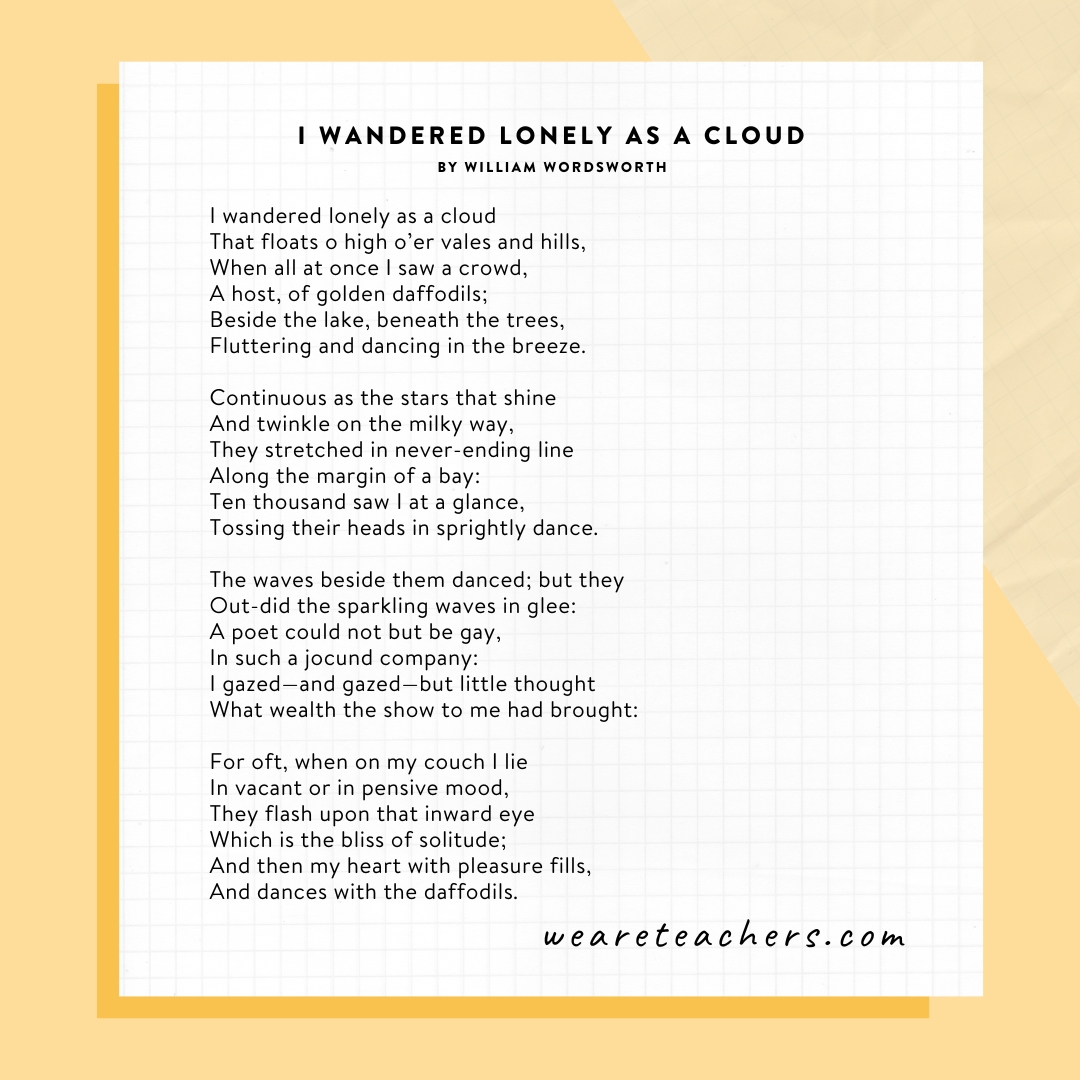
“I wandered lonely as a cloud
That floats o high o’er vales and hills …”
Themes: Memory, imagination, nature
Literary devices: Hyperbole, simile, personification, rhyme scheme, meter
This poem provides ample opportunity to point out various literary devices including similes such as “lonely as a cloud.” It also employs personification as it describes daffodils as dancing in the breeze. Finally, it exemplifies romantic ideals such as love of nature and finding beauty in the simple.
24. The Road Not Taken by Robert Frost
“Two roads diverged in a yellow wood …”
Themes: Reflection, uncertainty, individualism, nonconformity
Literary devices: Metaphor, imagery, personification, symbolism
Robert Frost’s works should be included on any list of famous poems. This poem is a great starting point for a unit on Frost as it gives students a chance to discuss Frost’s language and themes, exposes them to Frost’s poetry that touches on nature, and allows them to read multiple analyses of one poem.
25. Fifth Grade Autobiography by Rita Dove
“I was four in this photograph fishing …”
Themes: Childhood, nostalgia, play, family, relationships
Literary devices: Imagery, contrast, symbolism, enjambment
This poem uses vivid imagery to paint a picture of a time long gone and even family members who are no longer living.
26. The Facebook Sonnet by Sherman Alexie
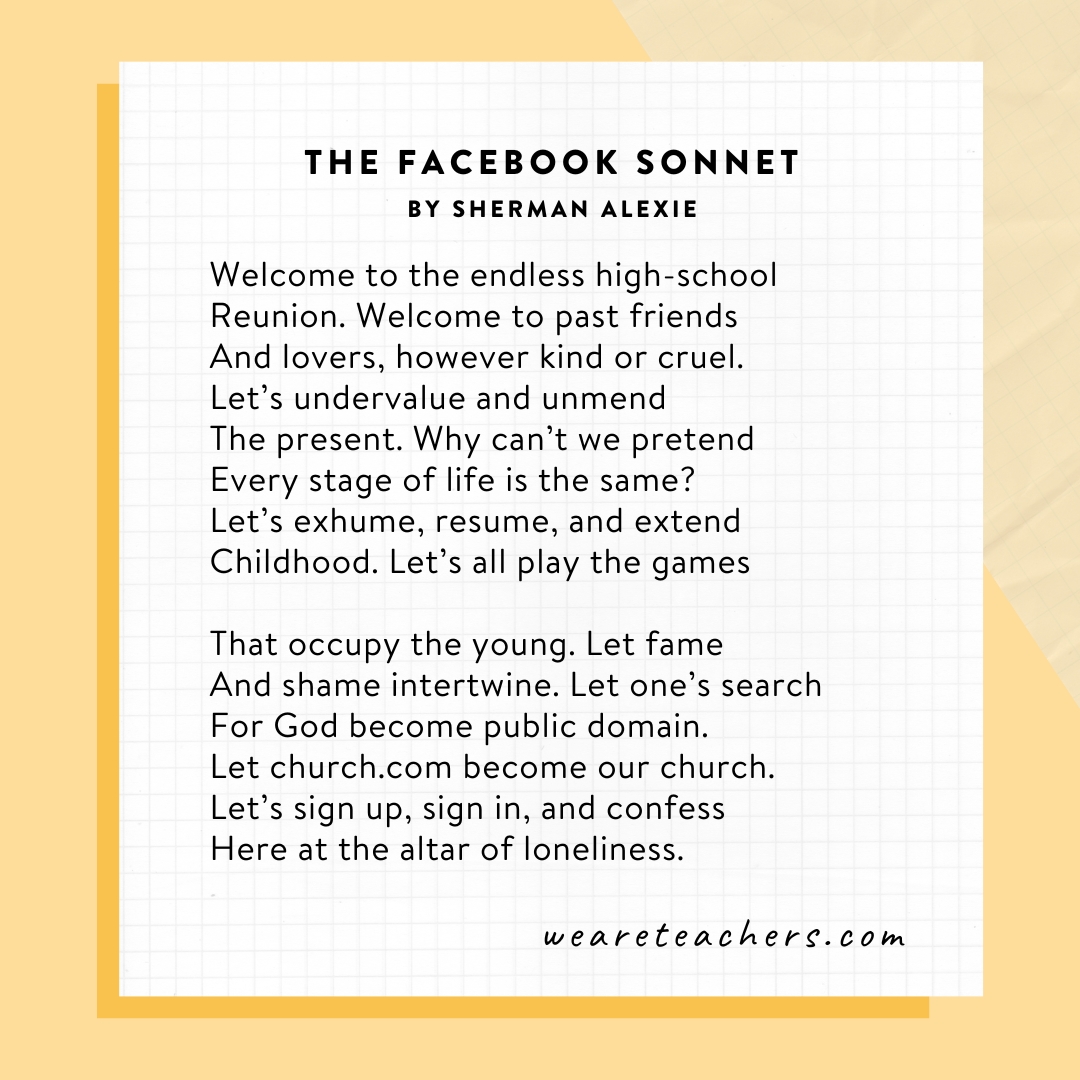
“Welcome to the endless high-school …”
Themes: Dangers of technology, past vs. present, commercialization
Literary devices: Satire, enjambment, rhyme
“The Facebook Sonnet” is a satirical poem that utilizes sarcasm to explore the pitfalls of social media, and Facebook in particular.
27. Casey at the Bat by Ernest Lawrence Thayer
“The outlook wasn’t brilliant for the Mudville nine that day …”
Themes: Baseball, defeat
Literary devices: Imagery, rhyme
This poem is perfect for kids who are obsessed with baseball, or for kids who think poetry is only about animals and seasons. “Casey at the Bat” is the epic poem about a baseball team, with lots of baseball vocabulary and scene building. Like many famous poems, it resonates with generation after generation.
28. Fire and Ice by Robert Frost
“Some say the world will end in fire …”
Themes: Negativity, duality, desire, hate
Literary devices: Imagery, symbolism, contrast, personification
“Fire and Ice” is one example of Frost’s versatility. It’s only nine lines long, but it packs a punch and was reportedly the inspiration for George R.R. Martin’s epic A Song of Ice and Fire. Talk with students about the imagery in the poem and the scenarios Frost imagines. Also, talk about the various ways this poem could be interpreted, line by line.
29. Text by Carol Ann Duffy
“I tend the mobile now
like an injured bird …”
Themes: Dangers of technology, modern era, isolation, miscommunication
Literary devices: Simile, symbolism, contrast
This poem is about our dependency on our phones and the miscommunication that can and does occur through texting. It provides good opportunity for teachers to review the consequences of technology with students while also learning about various literary devices.
30. Invictus by William Ernest Henley
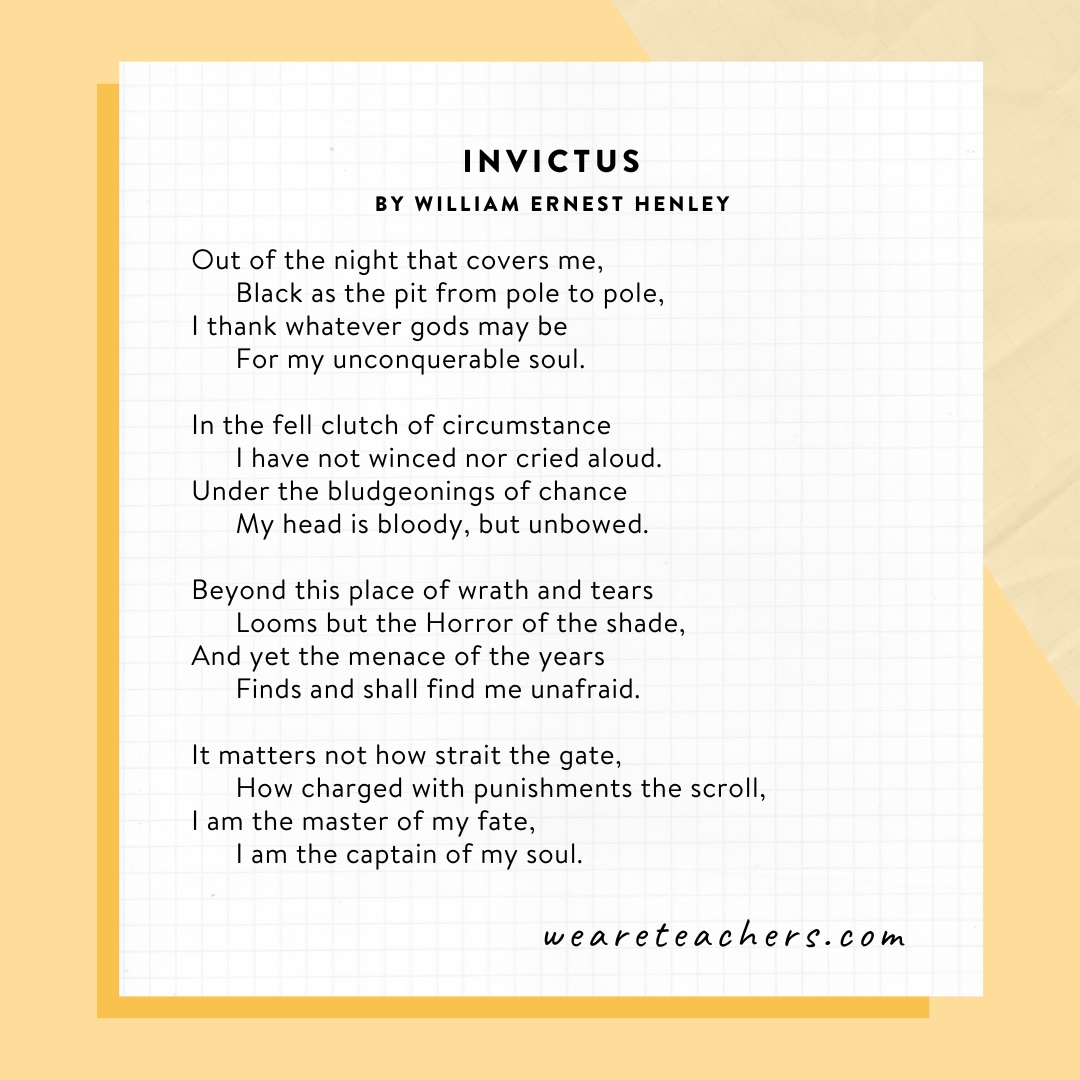
“Beyond this place of wrath and tears
Looms but the Horror of the shade …”
Themes: Destiny, free will, strength
Literary devices: Rhyme, imagery
This is not a subtle or very nuanced poem. It is, however, a great choice for students who tend to blame others for their lack of success, or sit back and let life happen to them, or who need a little push. The poem’s last lines, “I am the master of my fate / I am the captain of my soul,” express the kind of message that students these days desperately need.
31. Snow by David Berman
“Walking through a field with my little brother Seth …”
Themes: Change, nature, isolation
Literary devices: Juxtaposition, tone, imagery
“Snow” is a melancholy narrative in miniature. Berman discusses the complexity of human emotion within imagery of snow and the environment. Talk about the juxtaposition between the events and what’s happening and the beauty of nature.
32. The Tyger by William Blake
“Tyger Tyger, burning bright,
In the forests of the night …”
Themes: Power of nature
Literary devices: Imagery, rhetorical questions
This poem has advanced vocabulary (symmetry, immortal), and you can use one or more stanzas to teach students new words and talk about how the tiger was created. (Read it with “Tiger” by Valerie Worth to get two ideas on how tigers came about.)
33. The Hill We Climb by Amanda Gorman
“We, the successors of a country and a time where a skinny black girl …”
Themes: Change, nature, isolation
Literary devices: Juxtaposition, tone, imagery
Not all famous poems are decades or centuries old, and if you watched President Joe Biden’s inauguration in January 2021, it would be hard to forget Gorman’s stirring poem. It calls for unity, hope, and action.
34. I, Too by Langston Hughes
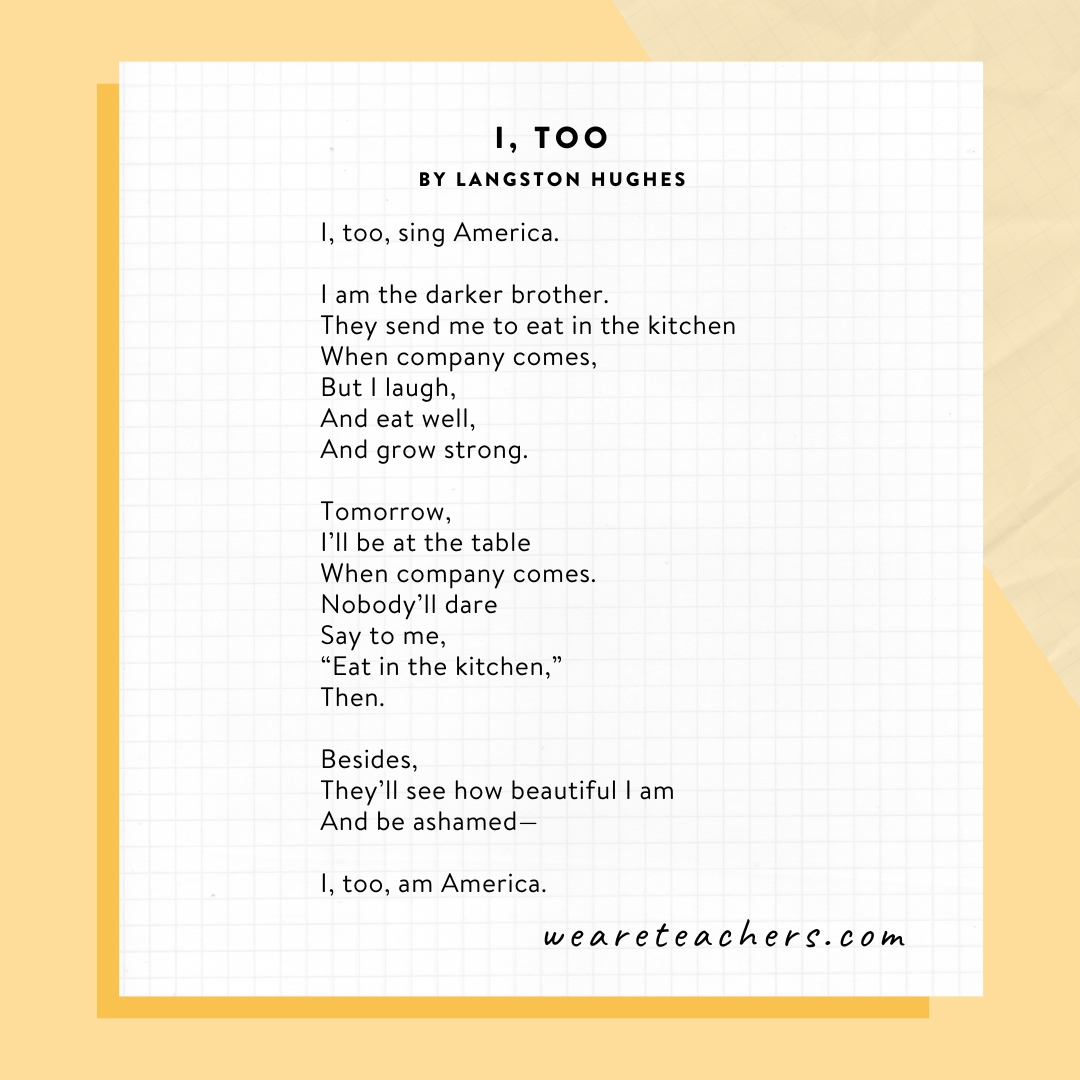
“I, too, sing America …”
Themes: Racial inequality, hope, resilience, American identity
Literary devices: Metaphor, imagery, allusion
Walt Whitman’s “I Hear America Singing” inspired Hughes to write this poem, noting that the Black American experience could be a very different one than that portrayed in Whitman’s poem.
35. Did I Miss Anything? by Tom Wayman
“Nothing. When we realized you weren’t here …”
Themes: Value of education, expectation vs. reality
Literary devices: Irony, satire, hyperbole
The disconnect between students’ and teachers’ perception of education is explored throughout this poem. The value of what is learned in a classroom is also disputed throughout the poem through the use of irony and contrast.
36. Sonnet 18: Shall I Compare Thee to a Summer’s Day? by William Shakespeare
“Thou art more lovely and more temperate …”
Themes: Love, beauty, time, immortality
Literary devices: Metaphor, imagery, symbolism
This poem is a good introduction to a Shakespearean sonnet, which has three quatrains (sections of four lines each) followed by a couplet of two lines. The rhyme scheme is ABAB, CDCD, EFEF, GG.
37. One Art by Elizabeth Bishop
“The art of losing isn’t hard to master …”
Themes: Loss, acceptance, denial vs. reality
Literary devices: Hyperbole, imagery, symbolism
This poem is a good introduction to the strict 19-line structure of a villanelle, with repeating lines and a rhyme scheme (ABA ABA ABA ABA ABA ABAA).
38. Sonnet 116: Let Me Not to the Marriage of True Minds … by William Shakespeare
“Admit impediments; love is not love …”
Themes: Eternal love, time
Literary devices: Personification, metaphor, paradox, symbolism
This sonnet attempts to define love by both describing what it is and also what it isn’t. The speaker ends the couplet with a statement of certainty saying that if love is not as he has defined it, then he has never written a word and no man has ever been in love.
39. For the Fallen by Laurence Binyon
“With proud thanksgiving, a mother for her children,
England mourns for her dead across the sea.”
Themes: Sacrifice, duty, patriotism, mourning
Literary devices: Personification, metaphor, imagery, rhyme, contrast
“For the Fallen” utilizes several literary devices, like metaphor, as the speaker compares stars to the night to fallen soldiers and their country. There is a solemn tone as vivid imagery paints a portrait of lives lost by juxtaposing those who have fallen with those who remain.
40. My Heart Leaps Up by William Wordsworth
“My heart leaps up when I behold
A rainbow in the sky …”
Themes: Joy in nature, continuity, innocence
Literary devices: Personification, symbolism, parallelism
In this brief but powerful reflection, Wordsworth expresses the deep, lifelong connection between nature and the human spirit. The poem is ideal for introducing Romantic ideals, especially the reverence for nature and the theme of “the child is father of the man,” emphasizing the importance of maintaining a sense of wonder into adulthood.
41. I’m Nobody! Who Are You? by Emily Dickinson
“Are you – Nobody – too?”
Themes: Anonymity, societal expectations, pitfalls of fame
Literary devices: Simile, rhyme, juxtaposition
Some short poems for kids are written by famous poets that didn’t necessarily write with children in mind. This poem juxtaposes the concept of being a nobody versus being a somebody. Dickinson makes it explicit throughout the poem that she values anonymity versus fame despite societal expectations.
42. The Highwayman by Alfred Noyes
“The wind was a torrent of darkness among the gusty trees.”
Themes: Love, loyalty and betrayal, revenge
Literary devices: Metaphor, simile, rhythm, narrative
When a highwayman meets the inn owner’s daughter, they fall in love immediately … as a rival eavesdrops. This narrative poem is another fun one to use with other narrative poems, like “Annabel Lee” and “The Cremation of Sam McGee,” to show how poets can be storytellers.
43. Success Is Counted Sweetest by Emily Dickinson
“By those who ne’er succeed.”
Themes: Success, fame, perspective vs. experience
Literary devices: Imagery, alliteration
Fame is a theme in Dickinson’s work. This particular poem was published anonymously in an anthology (Dickinson’s father did not think women should publish, and she published few poems during her lifetime). This poem begs the question, did Dickinson avoid fame because she wanted to protect her name or because she had already tried to seek fame and been rejected?
44. Mother to Son by Langston Hughes
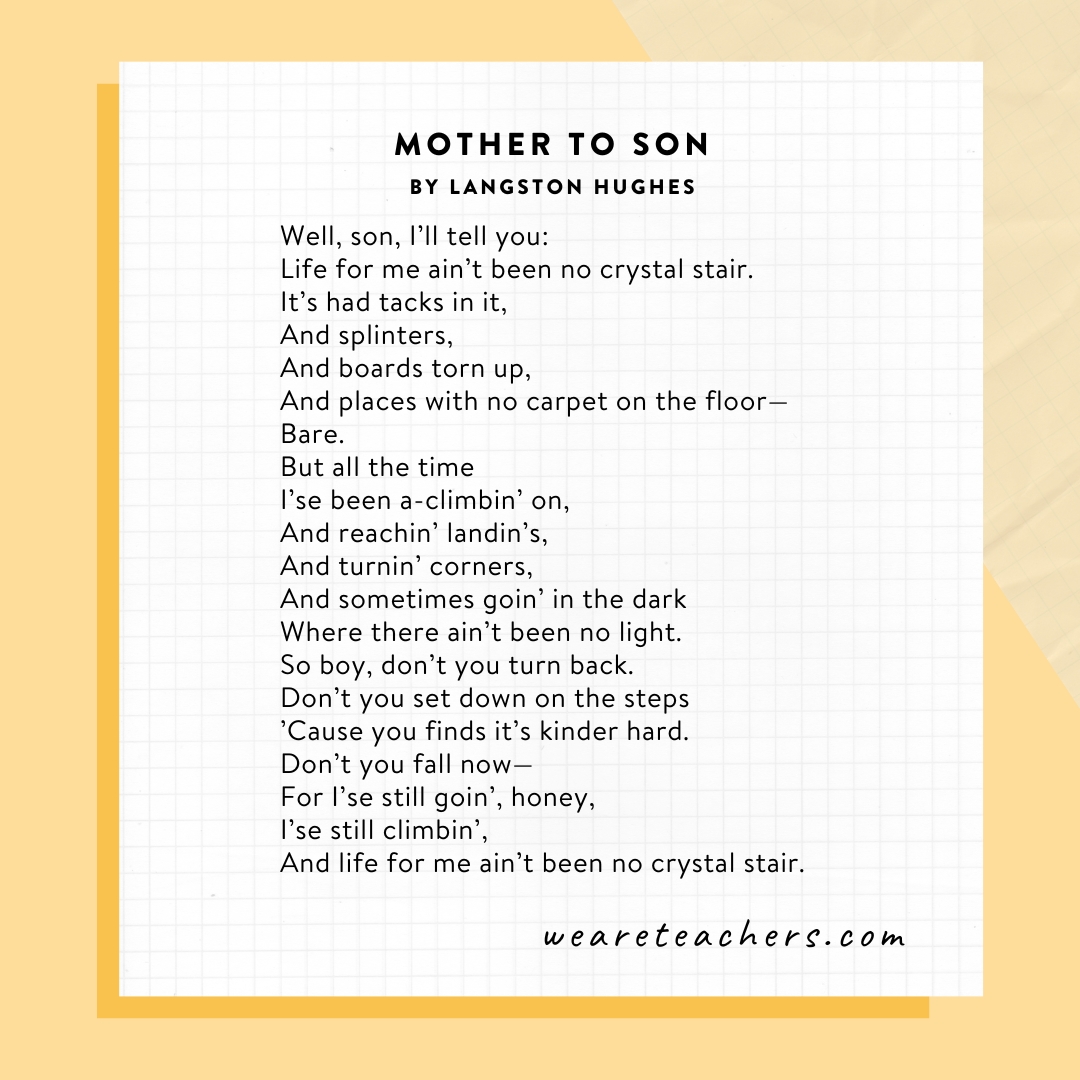
“Life for me ain’t been no crystal stair.”
Themes: Perseverance, resilience, hope and determination, parental love
Literary devices: Extended metaphor, symbolism, dialect, imagery, repetition
A Black mother eloquently urges her son to keep climbing through life despite setbacks and challenges. This is one of Hughes’ most beloved works, one everyone should read.
45. The Rime of the Ancient Mariner by Samuel Taylor Coleridge
“The Bridegroom’s doors are opened wide …”
Themes: Sin, redemption, guilt, consequences
Literary devices: Symbolism, personification, frame narrative
Coleridge’s famous poem is an example of a narrative poem where a story is framed within a story. An old mariner tells the story of a cursed sea voyage to a wedding guest. There are multiple themes and examples of symbolism within the story.
46. Song of Myself by Walt Whitman
“I celebrate myself, and sing myself …”
Themes: Spirituality and the soul, individuality, self-expression
Literary devices: Alliteration, repetition, imagery
This is a good example of a famous poem that’s a joyful and bold celebration of life, nature, and human connection.
47. She Walks in Beauty by Lord Byron
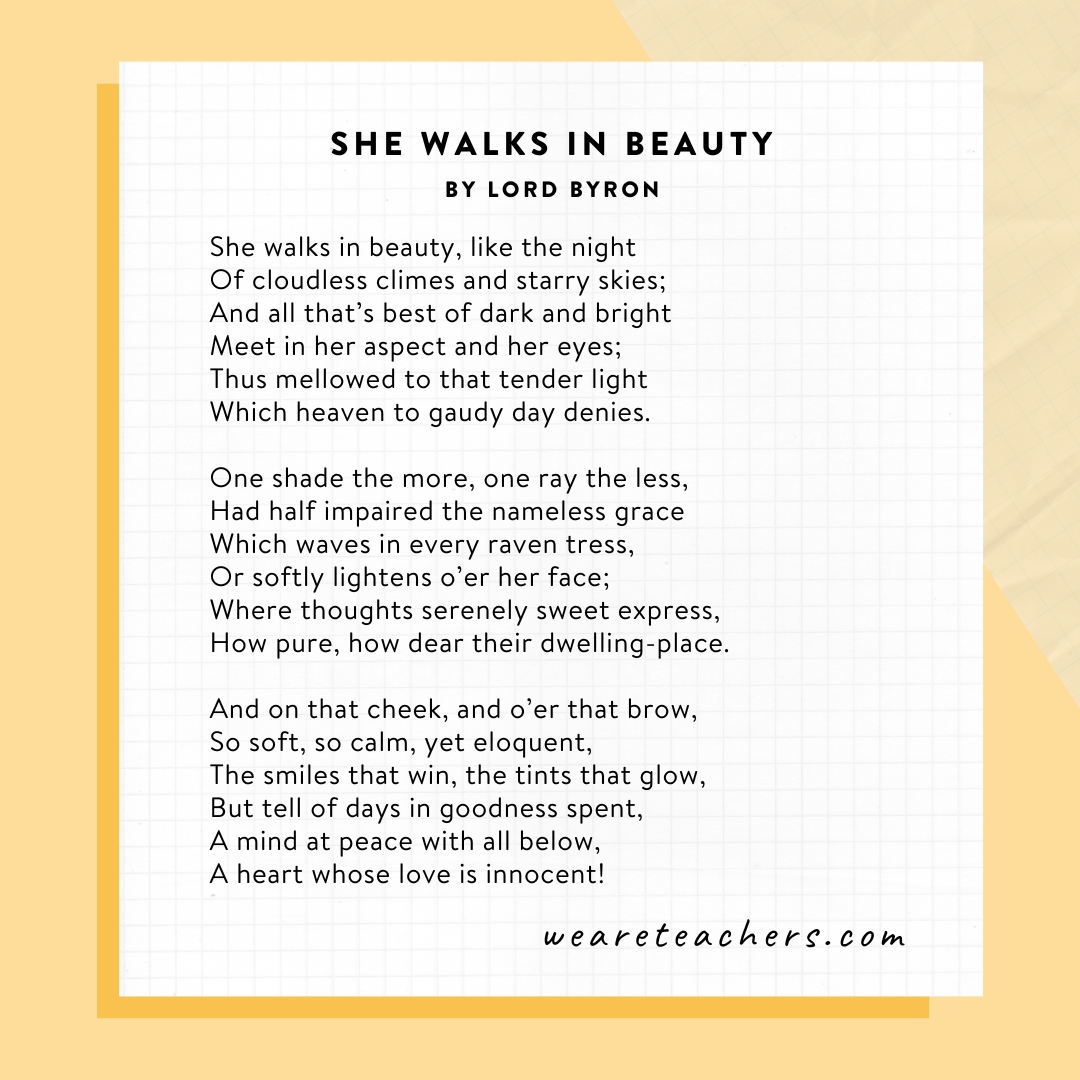
“She walks in beauty, like the night
Of cloudless climes and starry skies;
And all that’s best of dark and bright …”
Themes: Beauty, idealized love, purity
Literary devices: Imagery, metaphor, rhyme scheme
Byron describes a beautiful woman in this poem. Students can analyze it on its own or in comparison to other poems about beauty and identity, like those by Dickinson and Plath. This is also a good poem to include if you are talking about themes of love and how poets treat love in their works.
48. O Captain! My Captain! by Walt Whitman
“O Captain! my Captain! our fearful trip is done …”
Themes: Patriotism, mourning, leadership, responsibility
Literary devices: Extended metaphor, imagery, repetition, contrast
This poem is packed full of themes, literary devices, and historical reflections. The captain referenced is Abraham Lincoln, the “fearful trip” referenced is the Civil War, and the ship is the United States.
49. We Wear the Mask by Paul Laurence Dunbar
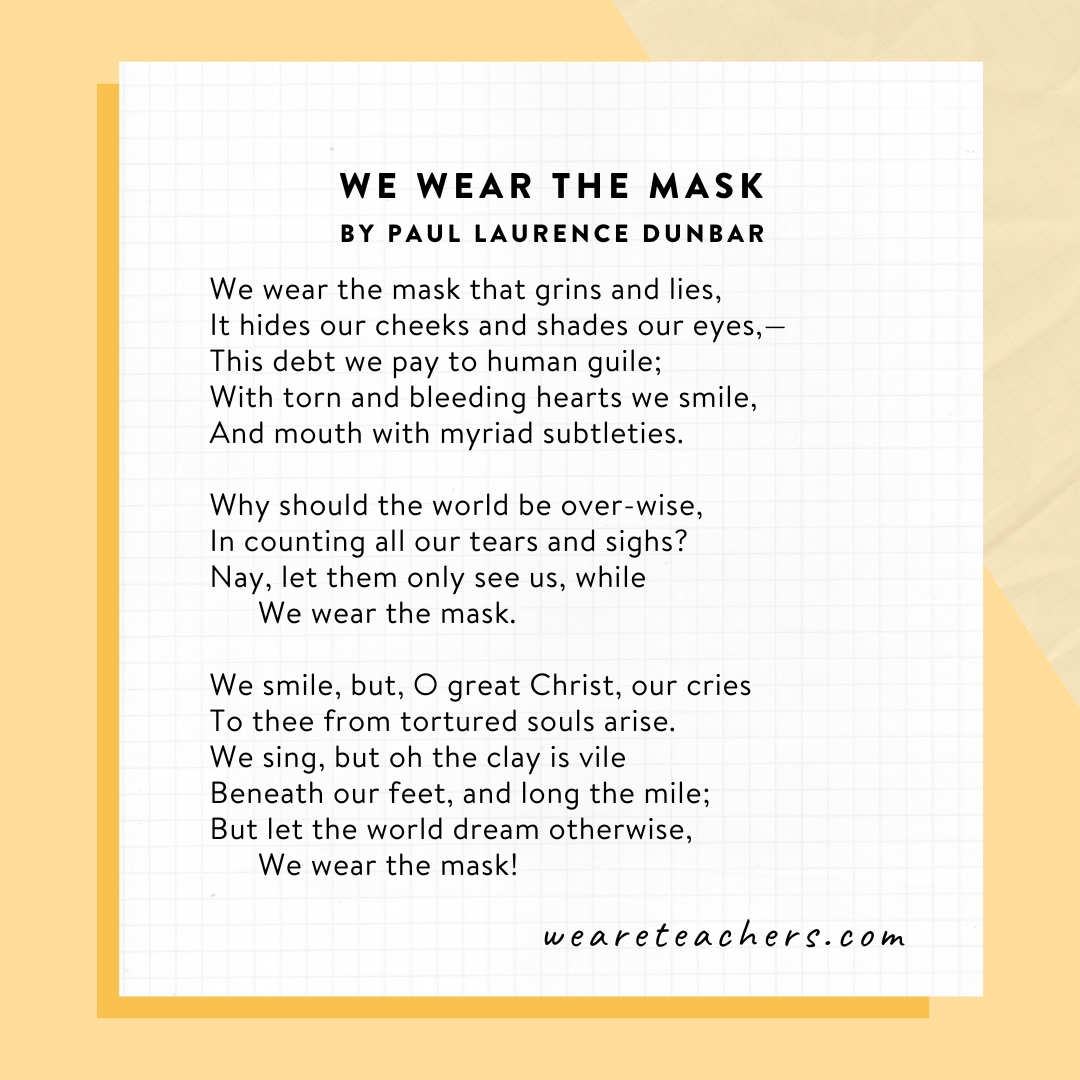
“We wear the mask that grins and lies,
It hides our cheeks and shades our eyes …”
Themes: Racial oppression, resilience, societal expectations
Literary devices: Metaphor, imagery, repetition
Dunbar’s timeless work explores themes of identity, resilience, and the emotional toll of hiding one’s true self. Its message continues to resonate across generations and cultures.
Famous Poems for High School
50. In Flanders Fields by John McCrae
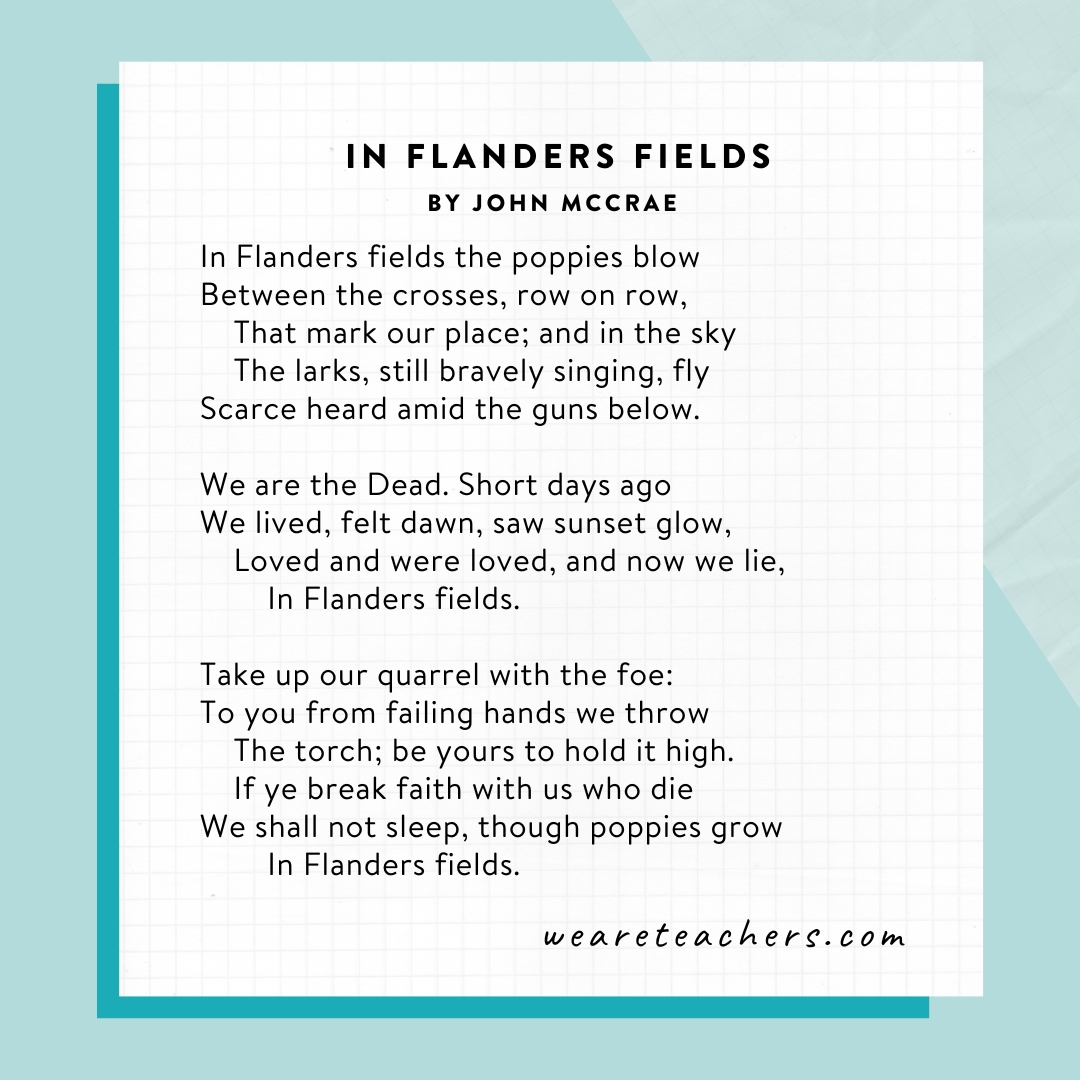
“We are the Dead. Short days ago
We lived, felt dawn, saw sunset glow …”
Themes: War, responsibility, patriotism
Literary devices: Metaphor, alliteration, symbolism, repetition
The poet Colonel John McCrae was a physician and soldier who created this poem following the death of a close friend in battle. There is historical context as well as lessons on various themes and literary devices throughout.
51. Ozymandias by Percy Bysshe Shelley
“I met a traveller from an antique land …”
Themes: Impermanence of power, ravages of time
Literary devices: Metaphor, allusion
This poem employs multiple literary devices to explore the nature of power. Ozymandias’ once mighty empire eventually decays away to nothing with time.
52. Do Not Go Gentle Into That Good Night by Dylan Thomas
“Rage, rage against the dying of the light …”
Themes: Fighting for life, resistance to death, regret
Literary devices: Villanelle, repetition, metaphor
This reflection on life, death, and the human drive to resist is a great one for close reading and line-by-line analysis. It’s also a villanelle, a 19-line fixed form with five tercets and final quintain, and students can analyze the structure and how it moves the poem forward.
53. Still I Rise by Maya Angelou
“You may write me down in history …”
Themes: Empowerment, resilience, triumph
Literary devices: Repetition, simile, rhetorical questions
Some famous poems, like this one, should be read aloud and listened to. Find videos of the poem being read by Angelou and other orators, and have students read it aloud to express the energy of the poem. Then, students can discuss what Angelou is saying about the African American experience, what she may have been responding to when she wrote it, and how the poem is relevant today.
54. Nothing Gold Can Stay by Robert Frost
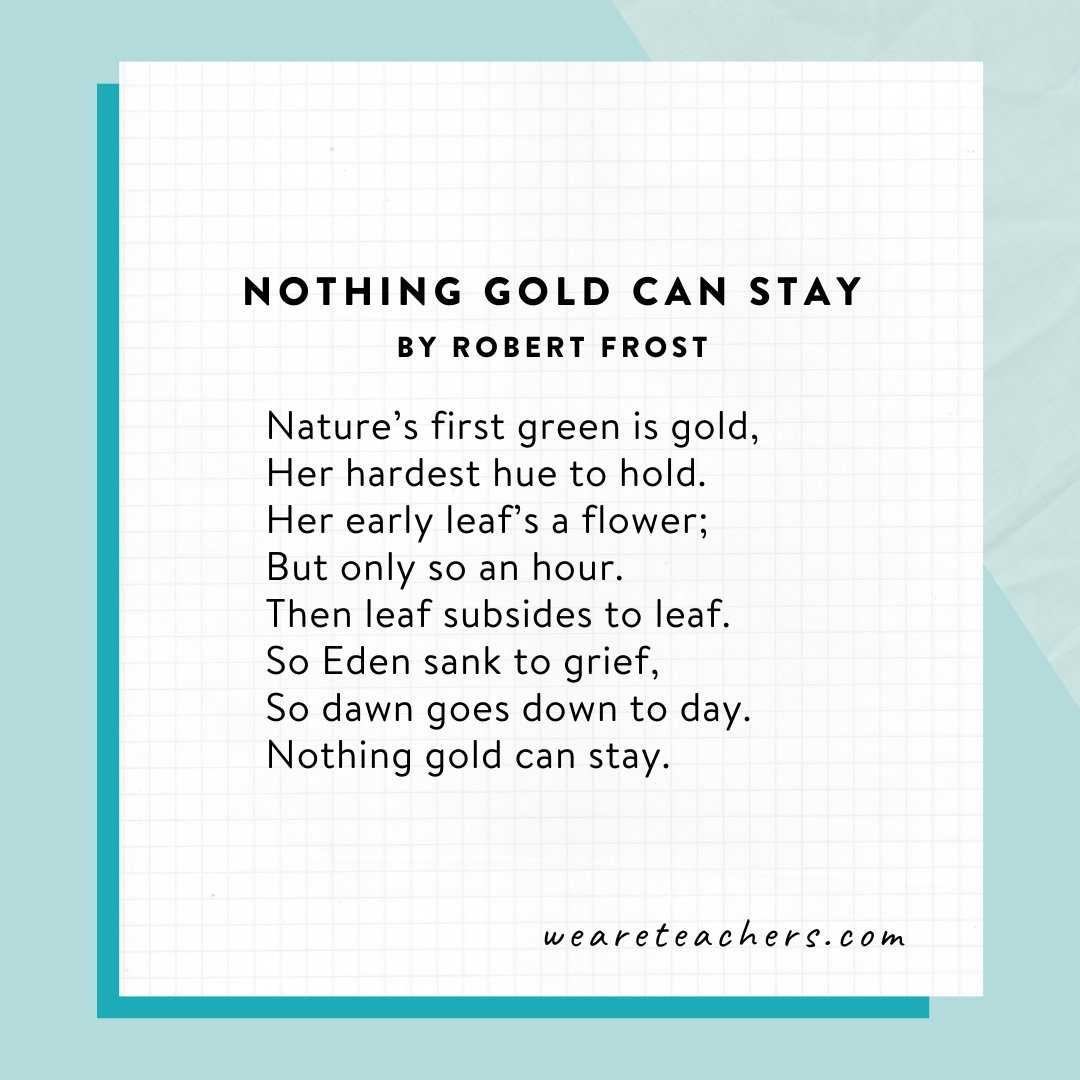
“Nature’s first green is gold …”
Themes: The life cycle, loss, regret
Literary devices: Alliteration, metaphor, personification
This poem is a great introduction to poetry that can be analyzed and discussed within a class period. Plus you can talk about how the poem relates to what students experience as they move through childhood milestones.
55. We Real Cool by Gwendolyn Brooks
“We real cool. We
Left school …”
Themes: Rebellion, youth, identity
Literary devices: Enjambment, rhyme, tone
This poem, about independence and defiance, speaks directly to the adolescent experience. Talk about what was happening in history when Brooks wrote this poem, and how it’s become a timeless poem. If you’re doing a poetry slam, this poem is great for students to read aloud and make their own.
56. The Laughing Heart by Charles Bukowski
“your life is your life …”
Themes: Embracing life, individuality, freedom
Literary devices: Imagery, repetition
In this uplifting poem that is written directly to the reader, Bukowski encourages readers to make the most of each day. It’s a good poem to incorporate into a poetry unit to lighten the mood or engage students in a carpe diem moment.
57. Harlem by Langston Hughes
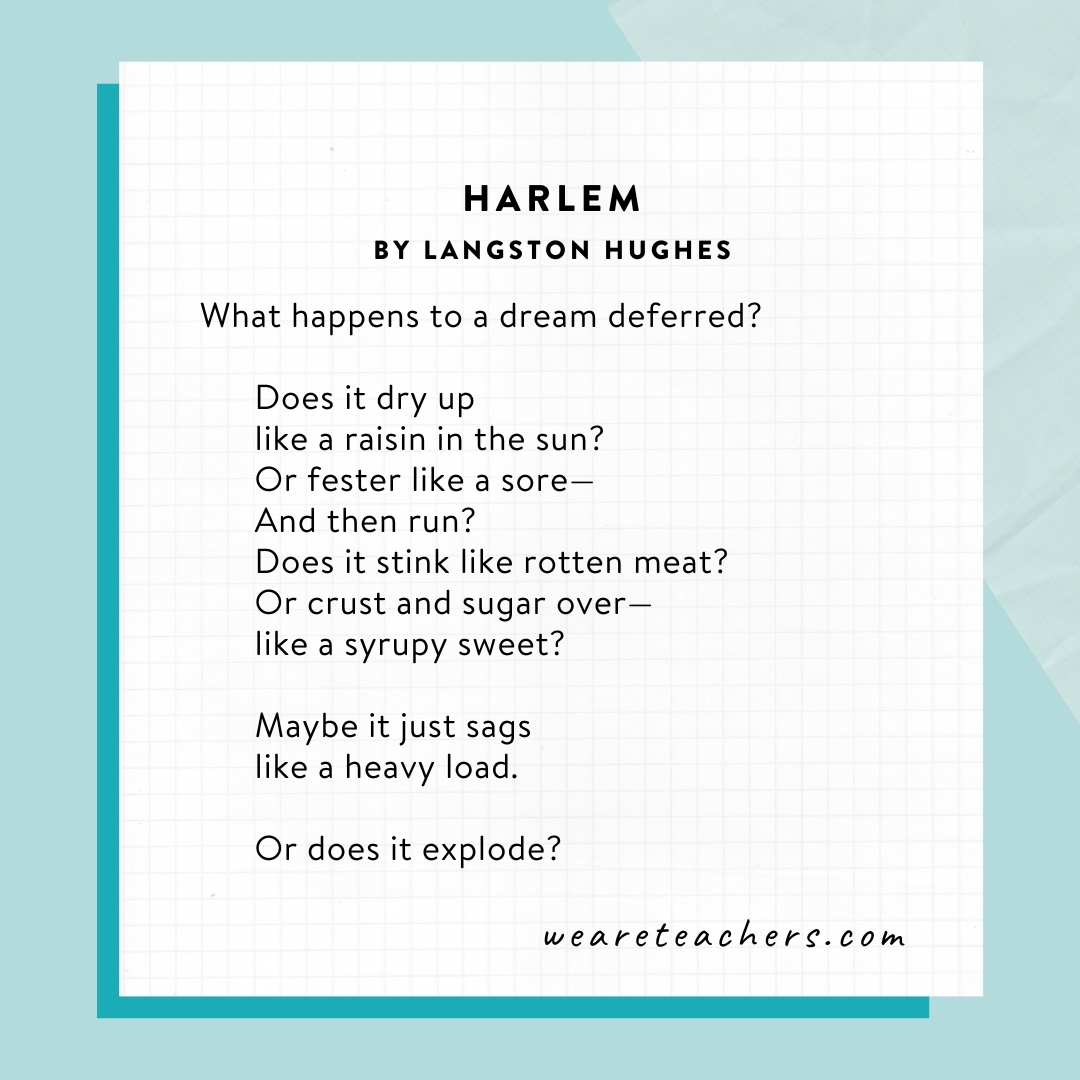
“What happens to a dream deferred?
Does it dry up
like a raisin in the sun?
Or fester like a sore—”
Themes: Frustration, inequality, hope
Literary devices: Simile, rhetorical questions
This poem has one of the strongest and best-known first lines. Take students through this poem line by line so they can discuss what Hughes imagines happens to a dream, and how that relates to the dreams they have or have had.
58. The Rose That Grew From Concrete by Tupac Shakur
“Long live the rose that grew from concrete …”
Themes: Perseverance, transformation, hope
Literary devices: Metaphor, symbolism, rhyme and rhythm
The late artist created a clear connection between the rhythm and deeper meaning of poetry and rap. Yes, this poem is good to engage students who are interested in music, but it’s also a good poem to analyze and connect to students’ lives as they go through their own transformative experiences.
59. If by Rudyard Kipling
“If you can keep your head when all about you
Are losing theirs and blaming it on you …”
Themes: Perseverance, courage, idealism vs. realism
Literary devices: Conditional structure, parallelism, personification, imagery, repetition
This famous work provides advice on how to live a virtuous life. Kipling uses repetition throughout by providing an if statement for how to act virtuously followed by contrasting it with an indication of how not to act.
60. Thirteen Ways of Looking at a Blackbird by Wallace Stevens
“Among twenty snowy mountains,
The only moving thing …”
Themes: Nature, humanity, simplicity vs. complexity
Literary devices: Symbolism, juxtaposition, free verse, allusion, imagery
This poem is broken into 13 separate stanzas, each of which contains a reference to a blackbird. “Thirteen Ways of Looking at a Blackbird” explores the different ways in which the human mind can perceive the world around it while employing vivid nature imagery and juxtaposing different outlooks.
61. Loud Music by Stephen Dobyns
“My stepdaughter and I circle round and round …”
Themes: Overwhelming emotions, human relationships, memory
Literary devices: Symbolism, contrast, imagery
Dobyns’ poem utilizes narrative style as well as vivid imagery to explore themes of human relationships and the power of emotion. In it, loud music serves as a symbol of the emotions felt.
62. Tattoo by Ted Kooser
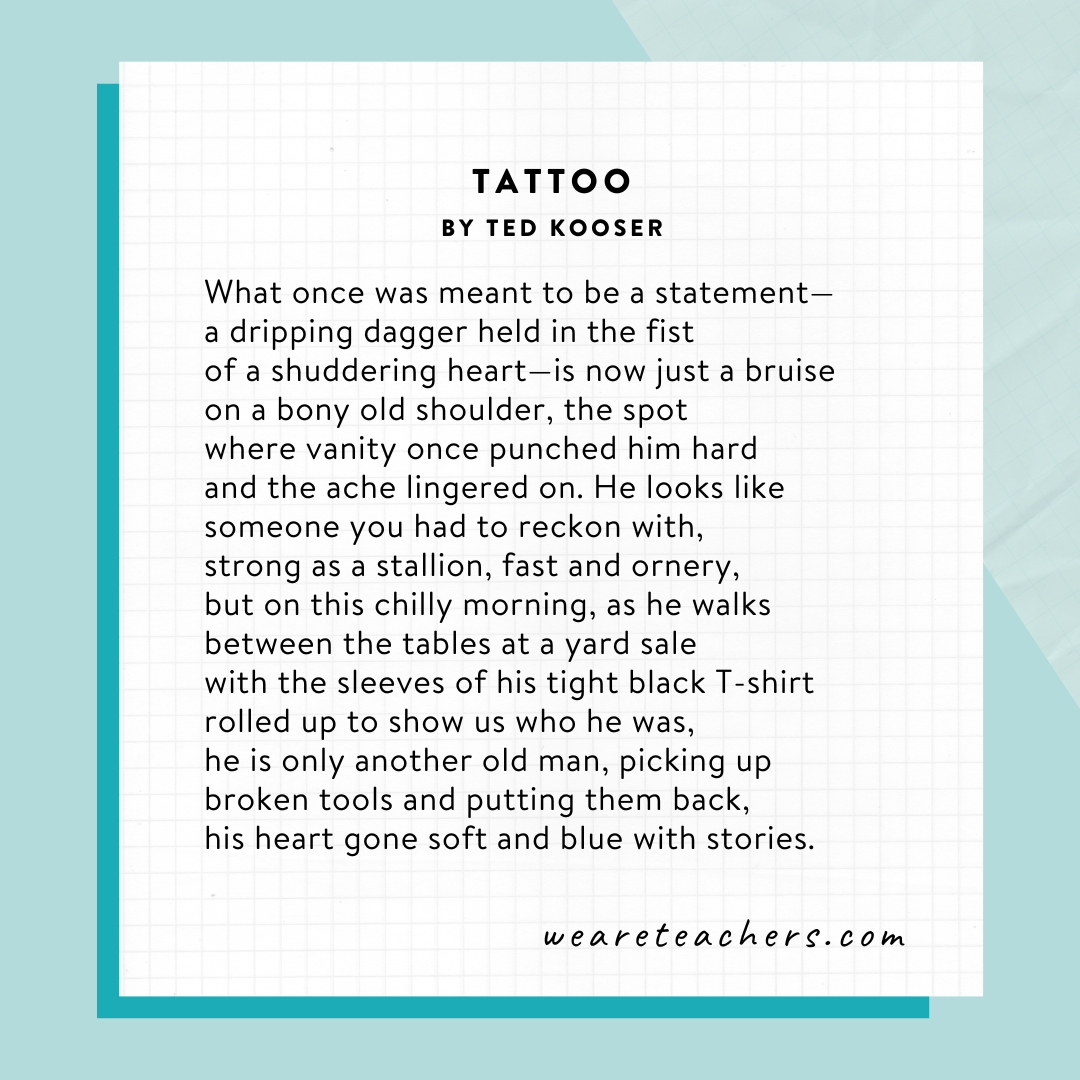
“What once was meant to be a statement …”
Themes: Aging, change
Literary devices: Enjambment, narrative
What stories can an old man’s tattoo tell us? This soft, lyrical poem about watching an old man who has a tattoo will resonate with middle and high schoolers because of the vivid images and wistful wondering about who this old man once was. Students can reflect on what their younger self might see if they came across their current selves, or what they may look like in the future.
63. Wheels by Jim Daniels
“My brother kept
in a frame on the wall
pictures of every motorcycle, car, truck …”
Themes: Masculinity, working-class identity, nostalgia
Literary devices: Imagery, symbolism
“Wheels” explores deep themes of loss, the passage of time, masculinity, and class through the use of symbolism and vivid imagery. Daniels paints a picture of the working class while conjuring up memories of his past and his lost brother.
64. Happiness by Jane Kenyon
“There’s just no accounting for happiness …”
Themes: Everyday joy, resiliency
Literary devices: Allusion, symbolism, contrast
The very nature of happiness is at the heart of this appropriately named poem. Kenyon utilizes vivid imagery and religious allusions to explore the ways in which joy can be found in both expected and unexpected places.
65. Miracles by Walt Whitman
“Why, who makes much of a miracle?
As to me I know of nothing else but miracles …”
Themes: Nature’s beauty and wonder, spirituality, interconnectivity
Literary devices: Free verse, repetition, imagery
While most people think of miracles as extraordinary and unlikely events, Whitman takes an opposite approach in this poem. Whitman reiterates throughout the poem his belief that miracles are found all around him in ordinary, everyday occurrences. Like so many of his other poems, the theme of nature takes center stage as he uses imagery to call to mind animals, birds, insects, etc.
66. In a Station of the Metro by Ezra Pound
“The apparition of these faces in the crowd …”
Themes: Fleeting moments, the beauty of everyday moments
Literary devices: Imagery, metaphor, juxtaposition
A brief glimpse of people’s faces in a busy place reminds the author of petals on a wet tree branch. This is an excellent example of how much can be communicated in just a couple of lines of poetry.
67. Hope Is the Thing With Feathers by Emily Dickinson
“And sings the tune without the words …”
Themes: Hope, nature, spirituality, resiliency
Literary devices: Metaphor, symbolism, contrast
This Emily Dickinson poem is among her most famous. It reads like a song (characteristic of Dickinson’s poetry). This is a good poem to start a unit on poetry as it’s life-affirming and, well, hopeful.
68. A Dream Within a Dream by Edgar Allan Poe
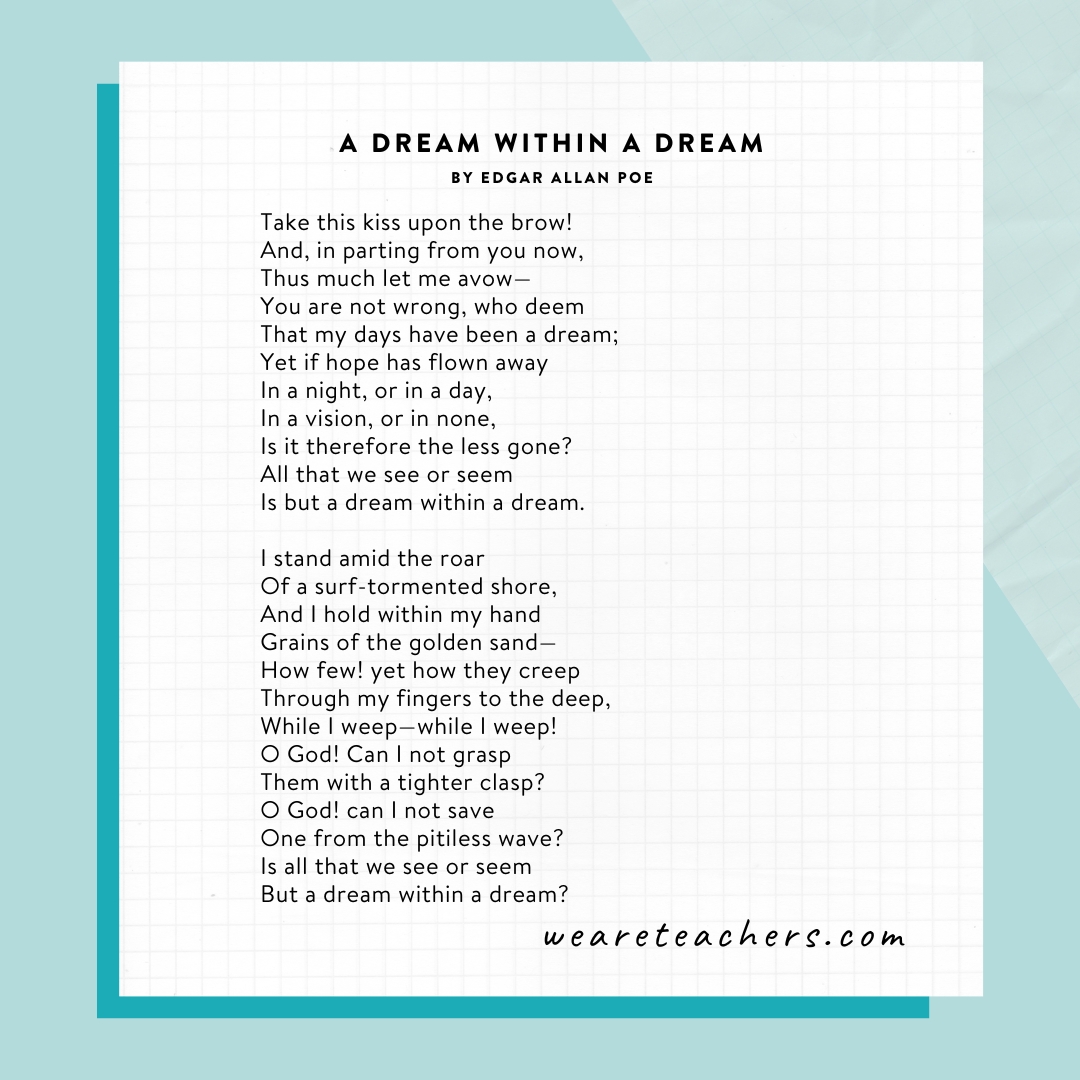
“All that we see or seem
Is but a dream within a dream.”
Themes: Fleeting nature of time, illusion vs. reality
Literary devices: Rhyme scheme, metaphor, imagery, repetition
“A Dream Within a Dream” is an introspective poem that delves into the nature of reality and the fragility of life. Poe was an expert at rhyme scheme—and this poem is clear evidence of that with its AABACDCD pattern. Use it to introduce and analyze rhyme scheme in a poem.
69. Falling in Love Is Like Owning a Dog by Taylor Mali
“Sometimes love just wants to go for a nice long walk.”
Themes: Love, companionship
Literary devices: Simile, metaphor, humor, satire
The very title of the poem itself is a simile comparing falling in love to owning a dog. While humorous, there is a deeper message within the poem that love certainly requires work and sometimes “needs lots of cleaning up after.”
70. Lies I Tell by Sara Borjas
“A woman has a window in her face: that is the truth.”
Themes: Identity, generational trauma, feminism, gender expectations
Literary devices: Imagery, repetition, sarcasm, Spanglish, allusion
“Lies I Tell” uses humor to explore themes of identity as well as family.
71. O Romeo, Romeo, wherefore art thou Romeo? (speech) by William Shakespeare
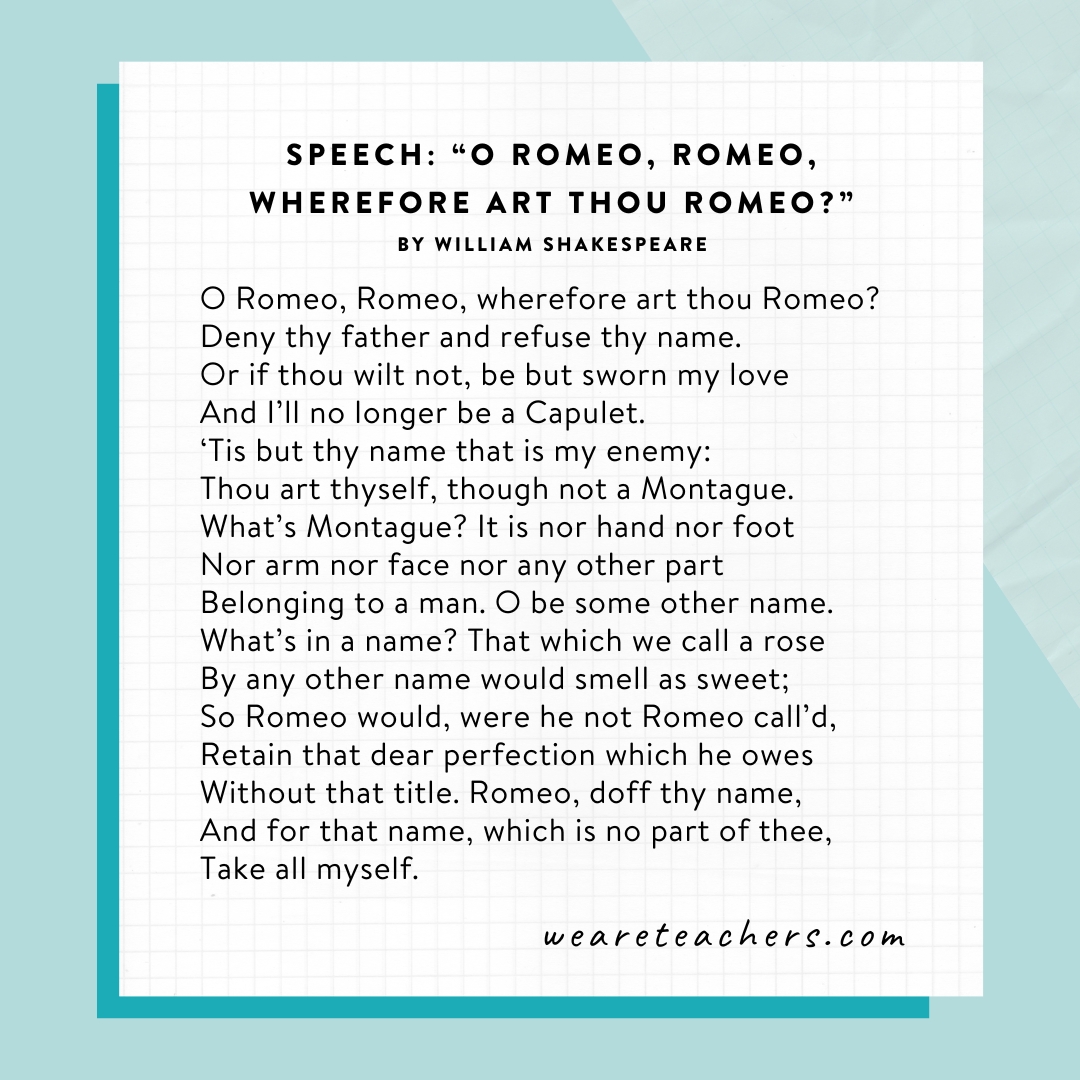
“Deny thy father and refuse thy name.”
Themes: Love, fate, conflict, death
Literary devices: Metaphor, soliloquy, pun
Everyone is familiar with the famous Shakespearean play “Romeo and Juliet.” This particular speech, given by Juliet, is rich with themes of loyalty, familial relationships, and love.
72. Lady Lazarus by Sylvia Plath
“A sort of walking miracle, my skin …”
Themes: Fate, resurrection, death, feminism, objectification
Literary devices: Metaphor, allusion
At the heart of this poem is the allusion to Lazarus, who was resurrected by Jesus in the Bible. Plath utilizes this allusion while wrestling with complex issues such as identity, mental health, and objectification.
73. Don Juan: Canto 11 by Lord Byron
“When Bishop Berkeley said ‘there was no matter,’
And proved it—’twas no matter what he said …”
Themes: Love and seduction, morality, fate, free will
Literary devices: Direct address, satire, irony
This satirical poem turns the story of Don Juan on its head, implying that he was the one being seduced rather than the one seducing. While humorous, it also provides societal commentary.
74. Daddy by Sylvia Plath
“You do not do, you do not do
Any more, black shoe …”
Themes: Family relationship, anger, resentment
Literary devices: Allusion, imagery, tone
Sylvia Plath is an author that students may discover during their high school years, so her poem is a good introduction to the classic writer. This poem explores a complex relationship between father and daughter while employing Plath’s unsparing tone.
75. I Sing the Body Electric by Walt Whitman
“The armies of those I love engirth me and I engirth them …”
Themes: The divine, individualism, immortality
Literary devices: Free verse, imagery, repetition
Initially published in 1855 in the first edition of Leaves of Grass, this free-verse poem was considered controversial and obscene during its time due to its themes of sexuality, sensuality, and the body. Whitman also seeks to bridge the gap between the body and the soul. Throughout the poem, Whitman investigates each of the parts of the human body and how they come together to form a whole.
76. A Dog Has Died by Pablo Neruda
“but now he’s gone with his shaggy coat …”
Themes: Companionship, sorrow, death
Literary devices: Imagery, enjambment
“A Dog Has Died” is a poem about sorrow, loss, and companionship. It explores the meaningful relationship between the speaker and his pet who has passed and having to accept the reality of that death.
77. Because I Could Not Stop for Death by Emily Dickinson
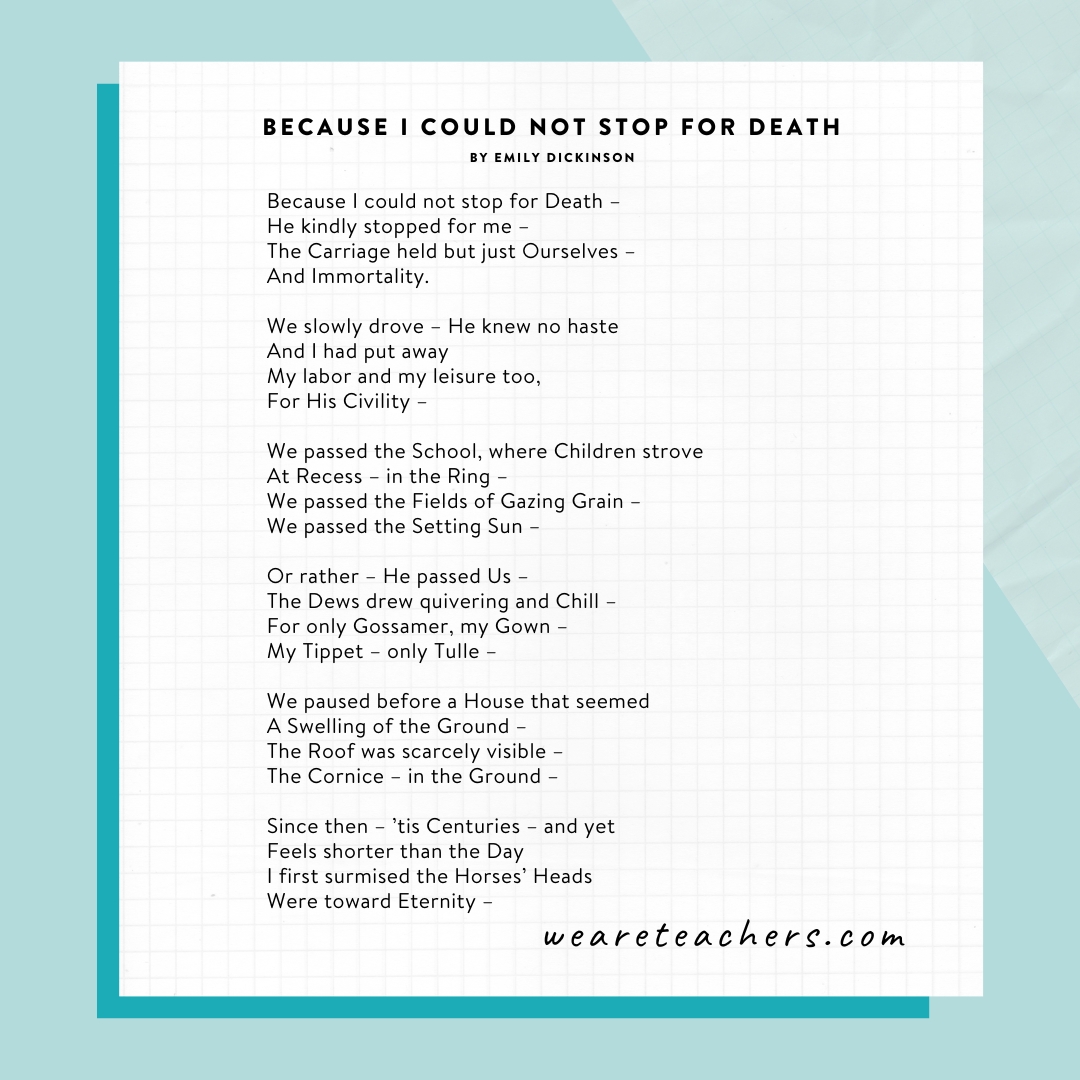
“Because I could not stop for Death –
He kindly stopped for me –
The Carriage held but just Ourselves –
And Immortality.”
Themes: Mortality, passage of time
Literary devices: Personification, alliteration
This classic, melancholic poem is among the many Emily Dickinson poems that deal with death and the afterlife. Just the first two lines provide a lot to talk about. But the poem is not dark—on the contrary, it’s hopeful and meditative.
78. The Raven by Edgar Allan Poe
“Once upon a midnight dreary, while I pondered, weak and weary …”
Themes: Grief, loss, madness, despair
Literary devices: Rhyme, repetition, symbolism
Published in 1845, toward the end of his life, “The Raven” is easily Poe’s most popular poem. The haunting rhyme and repetition throughout evoke an eerie mood that draws in even the most reluctant readers of poetry. Unlike some Edgar Allan Poe poems, this one uses accessible language that readers of all ages can understand and enjoy. Those who want to take a deeper dive will find allusions, poetic devices, and more that add further significance to these well-known verses.
79. The Waste Land by T.S. Eliot
“April is the cruellest month, breeding
Lilacs out of the dead land, mixing …”
Themes: Decay, death, memories of the past
Literary devices: Allusion, symbolism, imagery
You’ll definitely want to include “The Waste Land” in any unit on famous poems as this renowned work reflects on a world that is lost and broken after the turmoil of World War I.
80. Kubla Khan by Samuel Taylor Coleridge
“In Xanadu did Kubla Khan
A stately pleasure-dome decree …”
Themes: Imagination, power, the sublime
Literary devices: Imagery, allusion, rhyme
Coleridge’s fragmentary dream poem blends history and fantasy, creating vivid landscapes that explore the tension between human ambition and nature’s overwhelming force. This is ideal for studying Romanticism, the sublime in literature, and how imagination shapes poetic landscapes.
81. The Second Coming by William Butler Yeats
“Turning and turning in the widening gyre …”
Themes: Chaos, disorder, prophecy
Literary devices: Imagery, allusion, rhyme
“The Second Coming,” written in 1919 following World War I, explores the theme of societal turmoil.
82. To a Mouse by Robert Burns
On Turning her up in her Nest, with the Plough, November 1785.
“Wee, sleeket, cowran, tim’rous beastie …”
Themes: Uncertainty, humility, empathy
Literary devices: Metaphor, personification, rhyme
“To a Mouse” contains deep messages about the fragility of life and the empathy contained within animal and human relationships.
83. Composed upon Westminster Bridge, September 3, 1802 by William Wordsworth
“Earth has not any thing to show more fair …”
Themes: Nature, transience
Literary devices: Metaphor, personification, rhyme
Like much of Wordsworth’s poetry, this poem focuses on reverence for the natural world even in the urban setting of London.
84. Ode to a Nightingale by John Keats
“My heart aches, and a drowsy numbness pains …”
Themes: Mortality, beauty, transcendence, nature
Literary devices: Imagery, personification, symbolism, contrast
“Ode to a Nightingale” contrasts the fragility of human life against the immortality of the nightingale’s song. Various literary devices are employed to express the themes.
85. The Lady of Shalott by Alfred, Lord Tennyson
“On either side the river lie
Long fields of barley and of rye …”
Themes: Isolation, idealism vs. reality, fate
Literary devices: Allusion, imagery, repetition, symbolism
This is a narrative poem that recounts the story of the Lady of Shalott, who is confined to a tower and consequently forced to view the world indirectly through a mirror. Symbolism plays a major role in Tennyson’s exploration of themes like freedom and isolation.
86. The New Colossus by Emma Lazarus
“Not like the brazen giant of Greek fame …”
Themes: American identity, freedom, immigration
Literary devices: Imagery, personification, symbolism, contrast
This poem heralds America for its status as a sanctuary for those fleeing other lands because of hardship.
87. Howl by Allen Ginsberg
“I saw the best minds of my generation destroyed by madness, starving hysterical naked …”
Themes: Rebellion, critique of capitalism, suffering
Literary devices: Allusion, enjambment, anaphora
We love famous poems that tackle themes that transcend time and also generations. This poem is a bold political rant against capitalism, war, and politics and their contribution to the destruction of individuality and free choice.
88. Diving Into the Wreck by Adrienne Rich
“First having read the book of myths,
and loaded the camera,
and checked the edge of the knife-blade …”
Themes: Gender identity, language, power
Literary devices: Extended metaphor, imagery, symbolism
“Diving Into the Wreck” uses symbolism and vivid imagery to form an extended metaphor of a deep-sea dive into a shipwreck that represents a journey of self-discovery.
Get your free printable poetry worksheet bundle!
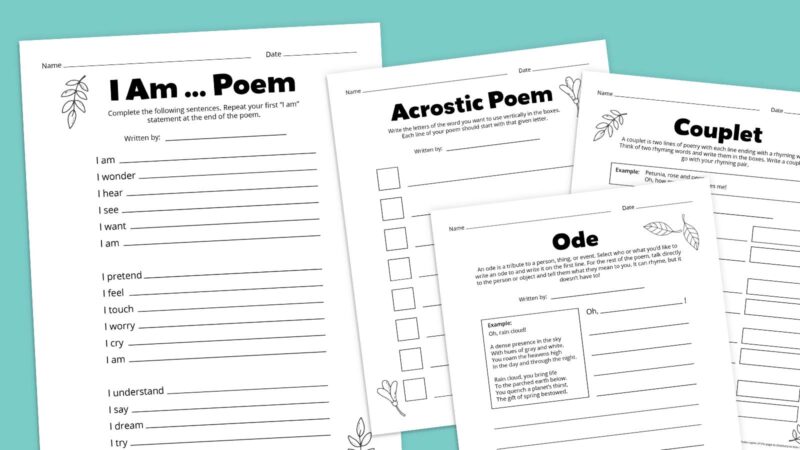
Are you ready to bring poetry activities to your classroom? Click the button below to receive our poetry worksheet bundle and get started!


